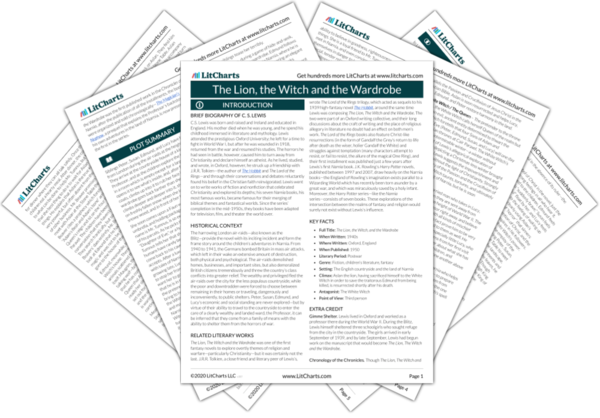Welcome to the LitCharts study guide on C. S. Lewis's The Lion, the Witch and the Wardrobe. Created by the original team behind SparkNotes, LitCharts are the world's best literature guides.
The Lion, the Witch and the Wardrobe: Introduction
The Lion, the Witch and the Wardrobe: Plot Summary
The Lion, the Witch and the Wardrobe: Detailed Summary & Analysis
The Lion, the Witch and the Wardrobe: Themes
The Lion, the Witch and the Wardrobe: Quotes
The Lion, the Witch and the Wardrobe: Characters
The Lion, the Witch and the Wardrobe: Symbols
The Lion, the Witch and the Wardrobe: Theme Wheel
Brief Biography of C. S. Lewis

Historical Context of The Lion, the Witch and the Wardrobe
Other Books Related to The Lion, the Witch and the Wardrobe
- Full Title: The Lion, the Witch, and the Wardrobe
- When Written: 1940s
- Where Written: Oxford, England
- When Published: 1950
- Literary Period: Postwar
- Genre: Fiction, children’s literature, fantasy
- Setting: The English countryside and the land of Narnia
- Climax: Aslan the lion, having sacrificed himself to the White Witch in order to save the traitorous Edmund from being killed, is resurrected shortly after his death.
- Antagonist: The White Witch
- Point of View: Third person
Extra Credit for The Lion, the Witch and the Wardrobe
Gimme Shelter. Lewis lived in Oxford and worked as a professor there during the World War II. During the Blitz, Lewis himself sheltered three schoolgirls who sought refuge from the city in the countryside. The girls arrived in early September of 1939, and by late September, Lewis had begun work on the manuscript that would become The Lion, The Witch and the Wardrobe.
Chronology of the Chronicles. Though The Lion, The Witch and the Wardrobe was the first published work in the Chronicles of Narnia, after the publication of all the installments, the books were organized and sold chronologically—The Magician’s Nephew, a prequel that explains the Professor’s backstory and his own adventures in the land of Narnia, is now presented as the first in the series.







